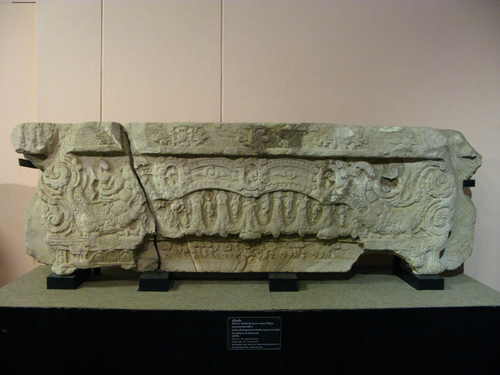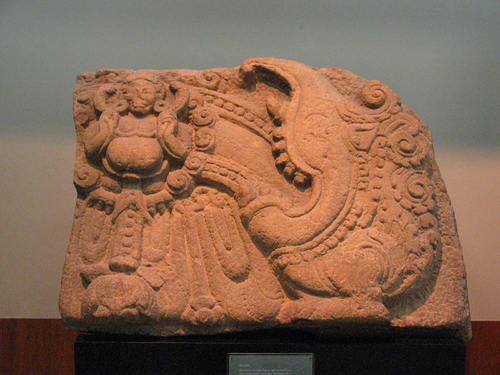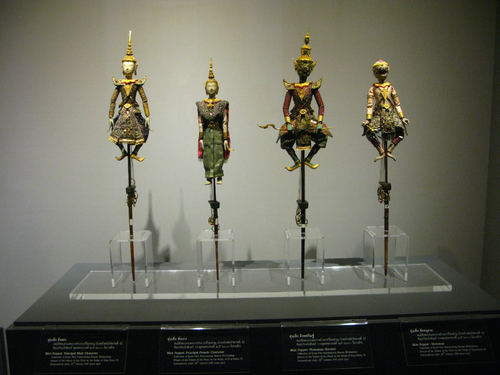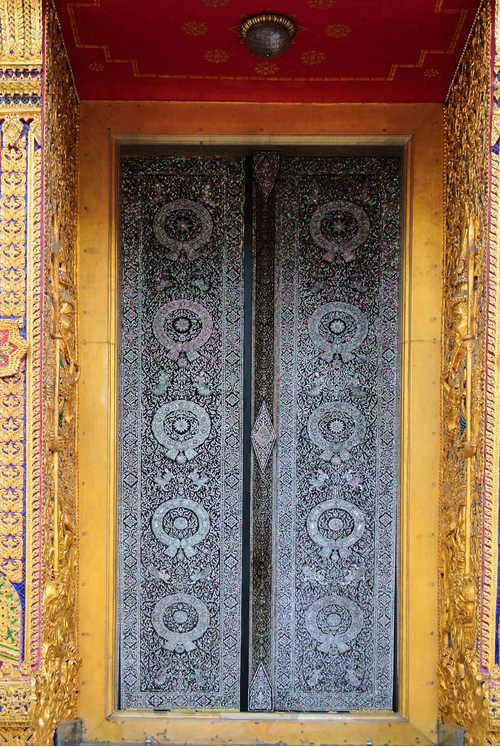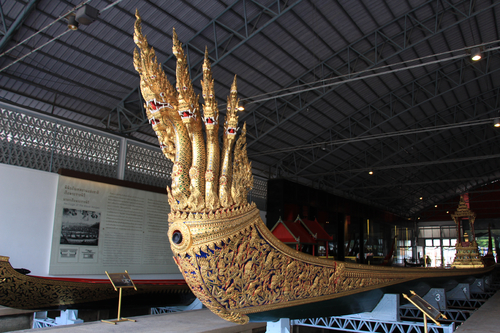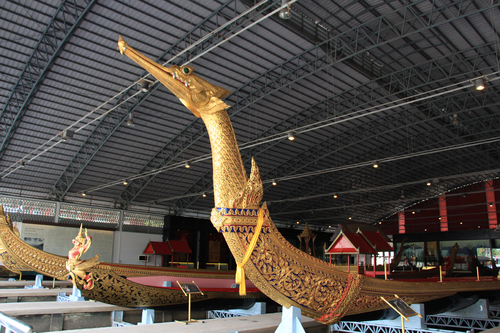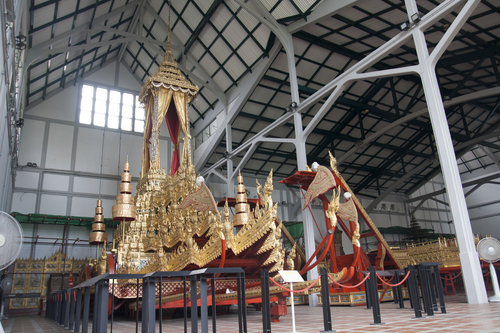ค้นหางานศิลปกรรม
ฐานข้อมูลศิลปกรรมในเอเชียตะวันออกเฉียงใต้
ประติมากรรมทับหลังจากปราสาทเขาน้อยหลังกลาง
การสลักเป็นรูปมกรสองตัวที่ปลายขอบทั้งสองข้างหันหน้าเข้าภายในคายวงโค้งออกมาสี่วง เหมือมกรมีรูปบุคคลขี่เบื้องบนกับเบื้องล่างของมกรมีฐานมารองรับ บริเวณกึ่งกลางและที่เสี้ยวที่ลายวงโค้งมาบรรจบกันปรากฏลายวงรูปไข่หรือวงรูปเหรียญสามวง ที่ขอบวงโค้งทั้งสี่วงมีลายประคำประดับอยู่โดยรอบ ส่วนที่ขอบของลายวงรูปเหรียญมีทั้งลายลูกประคำและลายใบไม้ม้วนประกอบอยู่ ภายในวงรูปเหรียญมีรูปเทวดาทรงพาหนะวงละหนึ่งองค์ ในขณะที่ภายในลายวงโค้งสองวงกลางมีลายดอกไม้สี่กลีบประดับอยู่ เหนือลายวงโค้งมีลายใบไม้ตั้งขึ้น ส่วนเบื้องล่างของลายวงโค้งสลักเป็นลายพวงมาลัยสลับกับพวงอุบะ ภายในลายพวงมาลัยมีลายใบไม้แหลมหยักอยู่พวงละหนึ่งใบ ส่วนพวงอุบะล้วนมีขนาดเท่ากันหมดทุกพวง รายละเอียดที่กล่าวมานี้สามารถเปรียบเทียบได้จากทับหลังปราสาทสมโบร์ไพรกุกหมู่ใต้ หลังที่ 7
ประติมากรรมทับหลังแบบถาลาบริวัต
ทับหลังมีสภาพชำรุดแตกหักออกเป็นสองชิ้น ชิ้นหนึ่งนั้นสาบสูญไป ส่วนชิ้นที่เหลือนั้นเริ่มจากการแกะสลักเป็นรูปมกรหันหน้าเข้าคายวงโค้ง ด้านหน้าปากมกรมีขอบเส้นตรงมารัดวงโค้ง ภายในวงโค้งนั้นเรียบไม่มีลวดลายมาประดับ ส่วนขอบวงโค้งทั้งด้านบนและล่างประดับแนวลูกประคำ ภายใต้วงโค้งเป็นลายพวงอุบะที่มีช่อกลางใหญ่ที่สุดห้อยสลับกับลายพวงมาลัยที่มีลายใบไม้สามเหลี่ยมอยู่ภายใน บริเวณที่วงโค้งแต่ละข้างมาบรรจบกัน ปรากฏรูปครุฑยุดนาคอยู่ภายในวงกลมรูปเหรียญ ครุฑนั้นมีหน้าเป็นมนุษย์ และปรากฏเฉพาะใบหน้าและลำตัวเท่านั้น
ประติมากรรมทับหลังแบบถาลาบริวัต
มีสภาพชำรุดโดยมีบางส่วนนั้นหักหายไป ส่วนที่เหลือนั้นแสดงภาพหัวมกรขนาดใหญ่คายวงโค้งออกมาหนึ่งวง วงโค้งนี้มีลายประคำประดับอยู่สองข้าง ตรงกึ่งกลางของทับหลังมีลายวงรูปไข่หรือวงรูปเหรียญขนาดใหญ่วงเดียวมีรูปครุฑยุดนาคอยู่ภายใน วงรูปเหรียญมีขอบขมวดเป็นลายก้นหอยแทนลายลูกประคำ ครุฑซึ่งอยู่ภายในวงรูปเหรียญนี้มีใบหน้าเหมือนบุคคลไว้ผมเป็นขมวด สวมตุ้มหูเป็นห่วงกลมขนาดใหญ่ รูปร่างอ้วนท้องพลุ้ย คาดเข็มขัดมีชายผ้าห้อยอยู่ด้านหน้าและใช้มือยุดนาคเศียรเดียวสองตัวด้วยมือแต่ละข้าง ส่วนขานั้นทำเลียนแบบขาของนกอยู่บนขอบวงรูปเหรียญ ทางเบื้องล่างใต้วงโค้งซึ่งออกมาจากปากของมกรและวงรูปเหรียญจำหลักเป็นลายพวงมาลัยสลับกับลายพวงอุบะ โดยที่อุบะพวงกลางใต้วงรูปเหรียญมีขนาดใหญ่กว่าอุบะพวงอื่นๆ ซึ่งเป็นลายอุบะแบบเก่าที่นิยมใช้บนทับหลังแบบถาลาบริวัติรุ่นแรกๆ
ประติมากรรมหุ่นวังหน้า
โครงหุ่นแกะเหลาด้วยไม้เนื้ออ่อนที่มีน้ำหนักเบาคว้านเจาะให้กลวงตลอดลำตัวเพื่อร้อยเชือกสำหรับชักให้อวัยวะบางส่วนเคลื่อนไหวได้หัวหุ่นโกลนด้วยไม้เนื้ออ่อนเช่นเดียวกับตัวหุ่นแล้วปั้นเสริมรายละเอียดบนใบหน้าด้วยรักปิดกระดาษเขียนสีตัดเส้นวิธีเดียวกับหัวโขนส่วนคอของหุ่นมีก้านไม้เล็กๆ ต่อยาวลงไปทางช่องกลวงกลางลำตัวสำหรับบังคับหุ่นให้หันหน้าไปมาได้ขณะที่เชิดอวัยวะส่วนต่างๆของหุ่นยึดด้วยเชือกเส้นเล็กๆมีสายเชือกสำหรับชักหุ่นโดยปลายสายชักมีห่วงสำหรับคนเชิดสอดนิ้วบังคับให้หุ่นเคลื่อนไหวหุ่นตัวพระที่สำคัญเช่นพระรามสีเขียวสวมชฎายอดบัดเครื่องประดับศีรษะหุ่นตัวพระมีทั้งชฎาเครื่องยอดและสวมกะบังหน้าประกอบกรรเจียกจอน เครื่องแต่งกายประกอบด้วยอินทรธนูสังวาลตาบทิศทับทรวงสวมสนับเพลาทับด้วยผ้าโจงมีผ้าห้อยหน้าผ้าห้อยข้างการแต่งกายของตัวพระคล้ายกับโขนหุ่นตัวนาง หากเป็นหญิงสูงศักดิ์เครื่องประดับศีรษะจะสวมชฎาหากเป็นยักษ์สวมรัดเกล้ายักษ์ที่มีศักดิ์ใช้รัดเกล้ายอดส่วนนางกำนัลใช้รัดเกล้าเปลว แต่งกายยืนเครื่อง นุ่งผ้าจีบยาวถึงข้อเท้า ห่มสไบสะพักสองบ่า สวมเครื่องประดับต่างๆ เช่นเดียวกับการแสดงโขนหุ่นตัวยักษ์มีการกำหนดศิราภรณ์ให้มียอดแตกต่างกันและมีสีกายรูปแบบของปากตาและอาวุธแตกต่างกัน โดยมีลักษณะเช่นเดียวกับการแสดงโขน เช่น ทศกัณฐ์กายสีเขียว หน้ายักษ์ตาโพลงปากแสยะเขี้ยวโง้ง เป็นต้น เช่นเดียวกับหุ่นลิงที่มีการกำหนดสีกายและลักษณะหัวโขนแตกต่างกันในแต่ละตัว
ประติมากรรมบานประตูประดับมุกลายเครื่องราชอิสริยาภรณ์
บานประตูพระอุโบสถบานซ้ายและขวามีลวดลายประดับมุกเป็นแบบเดียวกันคือ เครื่องราชอิสริยาภรณ์ทั้ง 5 ตระกูล ได้แก่1.เครื่องราชอิสริยาภรณ์อันเป็นโบราณมงคลนพรัตนราชวราภรณ์2.เครื่องขัตติยราชอิสริยาภรณ์อันมีเกียรติคุณรุ่งเรืองยิ่งมหาจักรีบรมราชวงศ์3.เครื่องราชอิสริยาภรณ์จุลจอมเกล้า4.เครื่องราชอิสริยาภรณ์อันเป็นที่เชิดชูยิ่งช้างเผือก5.เครื่องราชอิสริยาภรณ์อันมีเกียรติยศยิ่งมงกุฎไทยลายทั้งหมดประกอบด้วยมุกที่ตัดเป็นชิ้นเล็กๆ เรียงกันเป็นรูปดวงตรา ล้อมด้วยสายสะพายและสายสร้อยมีอักษร จ.ป.ร. ไขว้ และมีตราจักรีคั่นไปเป็นระยะ ซึ่งเป็นเครื่องราชอิสริยาภรณ์ชั้นสูงสุดแต่ละสำรับ นอกจากนี้ยังมีลายอื่นประดับใกล้เคียง ตามลำดับจากด้านบนดังนี้ใต้เครื่องราชอิสริยาภรณ์ดวงที่ 1 เป็นภาพเทพนม ใต้เครื่องราชอิสริยาภรณ์ดวงที่ 2 เป็นภาพเทพธิดาฟ้อน ใต้เครื่องราชอิสริยาภรณ์ดวงที่ 3 เป็นภาพกินนรรำ ใต้เครื่องราชอิสริยาภรณ์ดวงที่ 4 เป็นภาพหนุมานเหาะ ใต้เครื่องราชอิสริยาภรณ์ดวงที่ 5 เป็นภาพอินทรชิตเหาะ พื้นหลังทั้งหมดเป็นลายกระหนก ล้อมกรอบด้วยลายประจำยามก้ามปู
ประติมากรรมเรือพระที่นั่งอนันตนาคราช
โขนเรือพระที่นั่งอนันตนาคราชเป็นรูปนาค 7 เศียร กลางลำทอดบุษบกสำหรับเชิญผ้าพระกฐินหรือประดิษฐานพระพุทธรูปสำคัญ ลำเรือภายนอกทาสีเขียว ท้องเรือภายในทาสีแดง
ประติมากรรมเรือพระที่นั่งสุพรรณหงส์
โขนเรือเป็นรูปหงส์แกะสลักลวดลายกระหนก ลงรักปิดทองประดับกระจกลำตัวเรือทอดยาวคือส่วนตัวหงส์ ลำเรือด้านนอกทาสีดำภายในทาสีแดงกลางลำเรือทอดบัลลังก์กัญญาและกั้นพระวิสูตรสำหรับเป็นที่ประทับของพระมหากษัตริย์หรือพระบรมวงศานุวงศ์ เมื่อมีการพระราชพิธีจะประดับปลายปากหงส์โขนเรือพระที่นั่งสุพรรณหงส์ด้วยพู่ทำด้วยขนจามรีซึ่งนำมาจากประเทศเนปาลมีลักษณะเป็นขนสีขาวนุ่มละเอียด ปลายพู่เป็นแก้วผลึก
ประติมากรรมพระมหาพิชัยราชรถ
ราชรถช่วงล่างประกอบด้วยวงล้อ 4 ล้อ ส่วนหน้ารถเรียกว่าเกริน สลักลวดลายกระหนกออกปลายรูปหัวนาค ส่วนท้ายรถเรียกว่า ท้ายเกริน สลักลวดลายกระหนกออกปลายรูปหางนาค ส่วนกลางราชรถลดหลั่นเป็นชั้นๆ แต่ละชั้นประดับประติมากรรมรูปเทพนม เหนือฐานราชรถช่วงกลางประดิษฐานบุษบกเรือนยอด เสาย่อมมุมไม้สิบสองประดับพระวิสูตรผู้ไว้ทั้ง 4 ด้าน ฐานบุษบกสลักลายประจำยามก้ามปู กระจังตาอ้อย และเทพนม หลังคาบุษบกเป็นเรือนซ้อนชั้นและมียอดแหลม องค์ประกอบทั้งหมดปิดทองประดับกระจกสี
